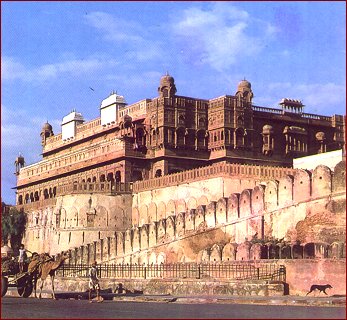Bikaner
is located in the extreme north of Rajasthan deep in the desert on the
ancient caravan route. Bikaner was founded by Rao Bhika in 1488.
He was the son of Jodha Singh who had founded Jodhpur.

This fortified
city stands at a slight elevation and is enclosed by a stone wall with
five massive gates. Several palaces, shrines can be seen here.
The most important fort is the Junagarh Fort. The fort was built
during the reign of Rao Rai Singh, one of Akbar's generals. The fort
is graced by 37 pavillions, balconies and windows. The arched Suraj
Pol serves as the entrance. Several palaces were constructed at later
dates, the most exquisite being the Anup Mahal, Badal Mahal, Lallgarh.
The
Junagarh
palace within the fort is an elegant structure
which was later modified and added to by successive rulers. It was
built with red sandstone and marble. In the mid 18th century Gaj
Singh contributed the
Chandra Mahal
(Palace of the Moon) with its mirrors, carved panels and paintings and
Phool Mahal (
Palace of Flowers) with its flower motifs inlaid with mirrors. Less
affected by war and destruction, they could concentrate more on the arts
and the famous Bikaner school of painting flourished. Several artefacts
and the decorations in the rajah's bedrooms are still intact, revealing
their love for art and beauty. An arched
doorway leads to the Joramal temple. Tar Mandir is the royal chapel
where royal weddings and births were solemnised.
The
Anup
Mahal built by Surat Singh is an even
more beautiful and graceful palace with wonderful carvings in red sandstone
on the walls and ceilings. Anup
mahal,
Rang Mahal
and
Bijay Mahal
have slender massive columns, cusped arches and delicate screens.
Lalgarh
was built by Maharaja Ganga Singh in the late 19th century, carved out
of red sandstone & now houses a museum known as Shri Sadul Museum and
also part of it functions as a hotel. The
Ganga
Golden Jubilee Museum houses artefacts
from various periods - pre Harappan civilizations, the Gupta & Kushan
eras, terra-cotta ware, weapons, miniature paintings of Bikaner school
and coins.
There is a
camel breeding farm
10 kms away, where tourists can enjoy a camel ride as well as get a taste
of camel milk.
Devi Kund
8 kms away is the royal crematorium, memorials to the Rathores of Bikaner.
The
Gajner Wildlife Sancturay
lies 32 kms away on the Jaisalmer road.
Laxmi Narain
Temple has been built near the ruins of
Rao Bika's old fort.
Karni Devi
Temple lies 26 kms south east of Bikaner
is considered an incarnation of Goddess Durga. According to legend,
she is considered to have performed several miracles. Her devotees
had lost their son & prayed to the Devi to revive him.

The goddess
reached the kingdom of Yama and asked for the boy's soul. When Yama
replied that the boy' soul had already been reincarnated, Karni Devi vowed
that souls of the members of the Charan clan (a caste of bards) would remain
within the body of rats until they can be reborn within the clan &
thus the temple provides sanctuary to rats. The rats scamper freely
round the temple & devotees feed them. The temple is finely sculpted
and has massive intricately carved silver gates which were donated by Maharaja
Ganga Singh.